In true Hill City fashion, Lynchburg’s “public square” is a vertical series of terraces climbing one city block from Church to Court Streets. Although it was conceived as a grand war memorial, Monument Terrace is also a practical set of pedestrian steps that connect two busy downtown streets, the Lynchburg Circuit Court Clerk’s Office, First Unitarian Church, and Mr. Elder’s Rose Garden. The National Register for Historic Places describes Monument Terrace as “one of the most impressive urban focal points in Virginia.” The entire ensemble of terraces, with the Doughboy statue and pool at the bottom and the 1855 Old Court House at the top, is the iconic heart of downtown Lynchburg.
Despite its massive stonework and imposing heights, Monument Terrace is a lively crossroads of urban life in Lynchburg. Tourists taking photographs along the terraces mingle with employees walking between businesses, downtown residents climbing the steps for exercise, brides taking formal portraits, a weekly veterans rally, and occasional vigils, marches, protests, and gatherings for every type of cause.
Over the decades, Monument Terrace has been host to a number of annual events and special occasions, including a community Christmas tree, local art show, and “flower mart.” It remains one of the most cherished civic spaces in the Hill City today.
Brief History
Ninth Street Steps
Monument Terrace was first developed as a public space in the early 1880’s. August Forsberg, the city engineer, was asked to provide a better route for citizens to move along the steep hill between Church and Court Streets. Forsberg designed a series of steps and landings down from Court Street that culminated in a large semicircular staircase at the intersection of Ninth and Church Streets. In the center of the stairs he planned a simple iron fountain.
On May 30, 1883, Lynchburg experienced a tragic fire in which five firemen were killed. Forsberg’s simple fountain was redesigned to add a fireman’s statue as a memorial to the men who lost their lives. This began Monument Terrace’s long history of honoring those from Lynchburg who gave the ultimate sacrifice.
Modern Monument Terrace
In the early 1920’s, energized by the economic prosperity of the decade and the new “city manager” form of local government, the Monument Terrace we know today began taking shape. Lynchburg’s first city manager Edward A. Beck is credited with originating the idea of transforming the old Ninth Street Steps into a modern civic space and memorial for local men who served in the recent “World War.”
Designed by local architect Aubrey Chesterman, the new plan called for a monumental set of steps and terraces made of Indiana limestone in Beaux-Arts and Renaissance Revival style. At the bottom of the steps, the Fireman’s Fountain was replaced with a new fountain featuring a large bronze dolphin, four turtles, and a scalloped shell backdrop. The project began in 1924 and was completed in the summer of 1925 at a total cost of $50,000.
“The Doughboy”
The dolphin fountain was soon replaced by a bronze statue by Charles Keck, officially titled “The Listening Post.” Commonly referred to today as “The Doughboy,” it depicts a typical American infantryman on the Western Front:
“The figure of the soldier at a listening post in the trenches is in full trench equipment. Alert and listening for the enemy over the parapet of the trench, he stands in heroic mold, being about eight feet tall. […] His right hand grips the rifle and his left hand holds on to the parapet, while he is in the position of listening for the approach of the enemy.” (The Lynchburg News, 4 July and 10 October 1926)
The News’s editors called Keck’s memorial “grim, yet inspiring.” The names of the 43 local soldiers, sailors, and marines who died in World War I are etched in limestone behind the bronze sculpture. The work was officially unveiled and dedicated on November 11, 1926, “in honor of the men of Lynchburg, Virginia, who served in the World War, 1914–1918.”
War Memorials
In 1986, as part of the city’s bicentennial anniversary celebrations, new memorials for World War II, the Korean War, and the Vietnam War were added to three of the “empty” terraces. Following the design of the World War I memorial, the new memorials included the names of every local man who died in each war.
Since 2000, additional memorials for prisoners of war (POW), those missing in action (MIA), and Purple Heart recipients have been installed. A bronze plaque recognizing those who died in the Gulf War (1990–1991) and Global War on Terrorism (2001–2021) was added in 2024.
Individual Terraces & Monuments

The monument “to commemorate the heroism of our Confederate soldiers” was erected along Court Street in 1900 opposite the Court House, now the Lynchburg Museum. The bronze sculpture shows a typical Confederate Army soldier and was cast by Von Mueller in Munich, Germany. This statue was erected in 1900 by the Old Dominion and Kirkwood Otey Chapters of the United Daughters of the Confederacy.
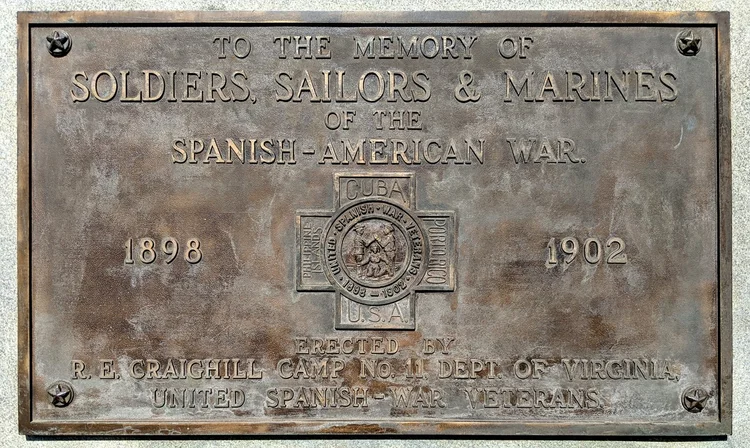
The first monument above the World War I sculpture and memorial wall is for the soldiers, sailors, and Marines who served in the armed forces during the Spanish-American War. This war lasted for only three months in 1898. The year "1902” on the bronze marker refers to the end of the U.S. occupation of Cuba and the establishment of the Republic of Cuba. The marker was erected in 1940 by the R. E. Craighill Camp No. 11, United Spanish-War Veterans.

Sculptor Charles Keck was hired by the City to create a monument to those killed during World War I (or “the Great War”). His bronze sculpture The Listening Post (or The Doughboy) was unveiled on Veterans Day in 1926 at the base of Monument Terrace.
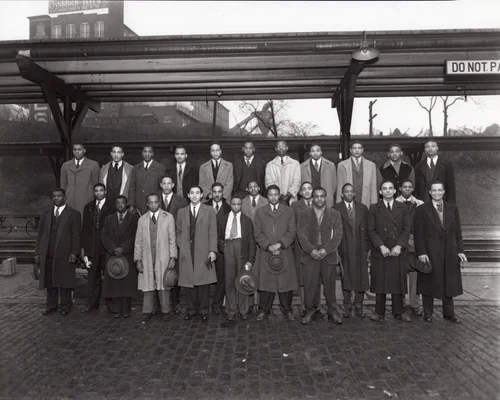
The World War II section features an inverted rifle with helmet, a symbolic image denoting the loss of a soldier. There are 182 names of Lynchburg men who lost their lives in the war inscribed on the wall nearby. Erected by the Lynchburg Bicentennial Commission in 1986.
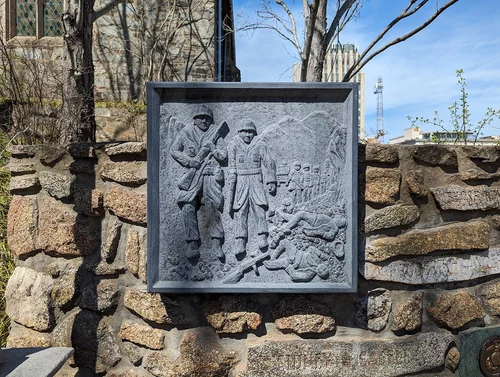
The Korean War monument bears the names of the 24 Lynchburg residents who lost their lives. It was erected by Co. B, 5th Battalion, US Marine Corps Reserves, in 1986 as a project for the city’s bicentennial anniversary.
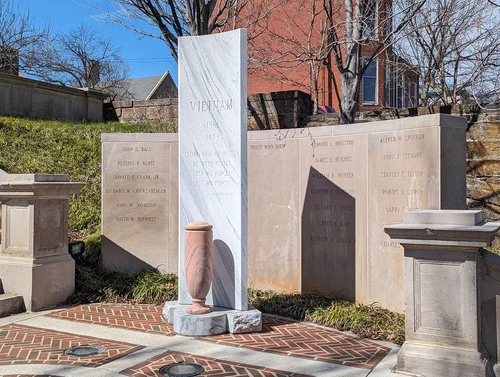
Lynchburg lost 27 men in Vietnam, and their names are listed on the monument. It was erected by the Vietnam Veterans of America, Chapter 196, in 1986 as a project for the city’s bicentennial anniversary.
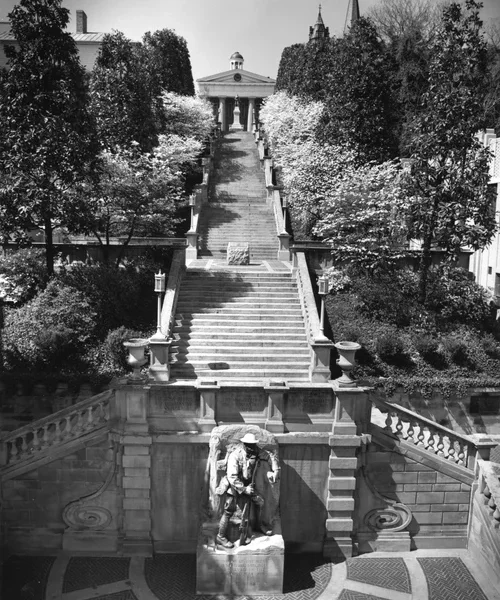
This monument pays tribute to those who were captured and held by the North Vietnamese and to those missing in action whose fate has never become known. Erected by the Vietnam Veterans of America, Chapter 196 in 2005.

The origin of the Purple Heart Medal dates to the American Revolution. The medal in use today was established in 1932 and given to those wounded or killed in time of war. It is estimated that 1.7 million medals have been given out since 1932. Erected by the Military Order of the Purple Heart in 2008.
More Information
Sculptor Charles Keck was hired by the City to create a monument to those killed during World War I (or “the Great War”). His bronze sculpture The Listening Post (or The Doughboy) was unveiled on Veterans Day in 1926 at the base of Monument Terrace.
The Doughboy figure is often incorrectly perceived as resting or being “at ease.” However, quite the opposite, he is depicted on duty at a military listening post, a position specifically established to detect enemy movements. The figure is alert and tense (see his left hand), ready to take action if necessary, and symbolic of the vigilance and readiness of America to defend democracy at home and abroad. Keck’s concept was uncanny in its foreshadowing of the second world war only 15 years later.
Inscribed on the wall behind the statue are local military unit designations and the names of 43 local men killed during the war. Following contemporary custom, the list is segregated by race, with two “Colored” soldiers (Franklin and Jones) identified after their White counterparts.
Keck designed many other statues, including two in Charlottesville, Virginia, that were removed in 2021: General Thomas “Stonewall” Jackson and explorers Lewis and Clark with Sacajawea.

Unveiling and dedication of the Listening Post sculpture and memorial wall, Veterans Day, November 11, 1926
Anderson, Joseph Leslie
Bacon, Lonnie Joseph
Barger, Howard T.
B(l)abnton, Felix
Blackford, Charles M.
Brooks, William Harrison
Brown, Joseph B.
Bryant, Harvey L.
Burks, J. Beverly
Butler, Robert Lewis
Butts, Herbert A.
Campbell, Alan Lile
Cobbs, William Offert
Christ, Jacob L.
Cumbie, Eugene
DuVal, Gabriel B. J.
Falwell, Thomas E.
Fallwell, Samuel
Fernald, Lewis C.
Finch, Guy V.
Fleming, Saunders
Fowler, Ivon H.
Fowler, Fred D.
Franklin, Robert Henry
Geophart, Fred G.
Glass, Henry B.
Glenn, George Preston
Guyer, Lawrence
Hall, John Handy
Harmon, John Randolph
Hillsman, W. W.
Hooker, Carl M.
Johnson, Robinson C.
Jones, Pannel R.
Kanger, Charles
Kessler, Robert Lee
Ketterer, William G.
Kirkpatrick, John
Koeing, Frank
Kuck, Maynard
Large, Arthur
Lee, Robert E.
Locher, Charles L.
Mawyer, Robert L.
Mays, Robert A.
Mitchell, Walter A.
Moon, Marvin A.
Moon, Stearnes
Murphy, John Joseph
Neubauer, William O.
Ore, Tommie
Ore, Orbie L.
Page, Willie E.
Paris, Lawrence D.
Paskiel, Reuben L.
Pendleton, Richard W.
Perrow, Robert L.
Printup, George G.
Shenk, Ambrose B.
Smith, Charles
Staples, Robert Bruce
Stevens, Henry (Carrington)
Stone, Charles E.
Thompson, W. Austin
Traylor, Norman J.
Walker, Harry S.
Widdifield, Clarence P.
Wills, John Howard
Witt, Abner Odell
Witzgall, Herbert J.
Wright, E. D.
Additional biographical & military service details are available upon request.
John W. Acree
Clifton Earl Adams
James R. Adams
John E. Adams
Donald Anderson
Robert H. Anderson
Roy W. Anderson
Carlos M. Bane
Hoyle H. Banton
William K. Barbour
Charles E. Beemer
Jack N. Binch
Eddie M. Bobbitt
Arthur J. Bolding
Withers F. Bolton
Richard Booth, Jr.
Charles A Bosiger
Harry P. Bowling
Allen L. Brewer
David S. Brizendine
Jesse Burns
Robert T. Burruss
Horace A. Byrd
Elest P. Campbell
Frank Carter
Wesley P. Carwile
John B. Chambers
Russell H. Cheatham
Vincent J. Clark
Warren K. Clemmons
Hansford A. Conner
Haywood A. Cox
Carlisle M. Craig
Edley Craighill, Jr.
William A. M. Dabney
Carroll W. Davis
John H. Davis, Jr.
William A. Davis
A. Dunn Dillard
Amos R. Dobson, Jr.
James T. Dolan
Charles A. Drewry
William E. Drinkard
Robert R. Driskill
William A. Drumheller
James A. Dunn, Jr.
James O. Edwards
Chalmas H. Elliott
Allie C. Field, Jr.
John E. Fogle, Jr.
Henry S. Fowler
Ernest J. Fox
Rutledge P. Fuller
Lonnie W. Gilliam
Walter R. Godsey
Frank G. Grayson
William T. Guill
John S. Hackworth, Jr.
Ralph L. Hackworth
Russell W. Hague
Henry R. Hamner
Charles W. Hanna
Vernon F. Harless
Clyde T. Harris
Giles B. Harris
Floyd J. Henley
Samuel L. Hitt
Ernest L. Howard
Mayburn L. Hudson
Robert H. Humphrey
Berkley H. Inge
Page H. Isbel
Ralph E. Jennings
Ernest F. Jessee, Jr.
Harry L. Johnson
James L. Johnson
James W. Johnson
Dan R. Justice
Alvin H. Justis, Jr.
Herman L. Keesee
Claude King, Jr.
James E. Kirby
Granville G. Kirby
Merlin F. Kulp
Jerome M. Lacy
William D. Langhorne, Jr.
Walter E. LeFew
Robert T. Lemmon, Jr.
Thomas J. Ligon Jr.
Walter L. Maddox, Jr.
Frank E. Marcus, Jr.
Edmund W. Marsh
Samuel F. Marshall
McClure D. Martin
Samuel E. Martin
Mack C. Mason, Jr.
Robert M. Mason
William E. Mayberry
E. Byron Meador, Jr.
Norman D. Meredith
James P. Mitchell
Raymond T. Moore
William Pryor Morgan, Jr.
Charles H. Mountcastle
Maynard I. Moyer
Warren Moyer
Henry A. Murphy
James U. Myers
William E. McCarthy, Jr.
Lawrence E. McCraw
Samuel M. McNutt
Harold Nase
Harry L. Norvell
William J. Nuckles
George H. Orchard, Jr.
Mark I. Overstreet
Frank W. Page
Walker L. Parrish
Grant G. Parsons
West A. Payne
Zebulon V. Penny
Samuel D. Perkins, Jr.
Lewis Pettigrew
James G. Phillips
Luther W. Pickeral, Jr.
Raymond E. Powell
Paul L. Price
Coleman D. Ramsey
James E. Reid
Thomas D. Reese
Leonard J. Riley
Clarence Roberson
David P. Rorer, Jr.
James E. H. Rumbough
David M. Russell
Phillip N. Russell
Bertram H. Sadler
Curley Scott
William P. Shelton, Jr.
James R. Silby
Charles A. Simmons
Thomas E. Sligh
William H. Smith, Jr.
Clyde T. Spencer, Jr.
Herman O. Sprouse
Gerald H. Staton
Henry C. Staton
William A. Stedman
Harry N. Stone
William G. Suhling. III
Baldwin Tanner
Andrew H. Thompson
Russell M. Thurmond
Perry L. Tomlin
Cornelius E. Tomlinson
Chester E. Trent Jr
Thomas A. Trent
George T. Tuck
Harold R. Tuck
Raymond W. Tweedy
John Walter Twitty, Jr.
Edward C. G. Tyree
James Russell Volk
George N. Wade
Ronald P. Wade
Howard E. Walker
David G. Waller
Robert B. Ware
Robert G. Ware
Percy E. Watlington, Jr.
James T. White
Henry B. Williams
Robert H. Williams
Ralph G. Wingfield
Daniel P. Womack
Randolph M. Wood
Kenneth L. Wooldridge
James A. Wright
Massie L. Wright
Samuel L. Wright
Vennie O. Aker
Robert H. Anderson
Garland Samuel Brown
Solomon M. Brown
Bobby L. Burford
Sidney A. Cabell
Wilbur O. Caul
Robert H. Conley
Douglas L. Drinkard
James C. Glass
Carlton E. Hall
Frank B. Howze
Ralph O. Hubbell
Arthur E. Johnson
Duncan A. MacLeod
Harold R. Mann
Roy W. Miller
Robert Douglas Ramsey, Jr.
Sherwin V. Smith
Jebru Trent
James T. Walker
Walter Conrad Watson
Otho T. Winstead
Eugene T. Woolridge
John Dabney Bass
Russel Keith Blatz
Donald E Clark Jr.
Richard Way Crickenberger
John Wayne Davidson
David Wayne De Priest
Stephen Finney
Harry Burkley Forbes
Larry Edward Francis
Raymond Lee Goodman
Roger Wayne Grubbs
Robert Edward Hall
Eugene David Harvey
Elwood Layton Houston
James Edward Hughes
William Kenneth Hunter
Calvert James Johnson
Richard Junior Jones
Aubrey Reid Mays
Kenneth Arthur Shannon
Alfred William Spinner
John Francis Stewart
Stanley Edward Taylor
Robert Daniel Unrue
Larry Francis Wirt
James C Wood
Charles Fred Wright
Additional biographical & military service details are available upon request.

